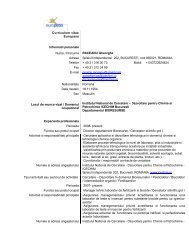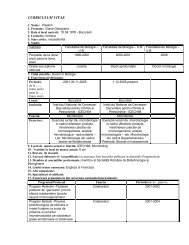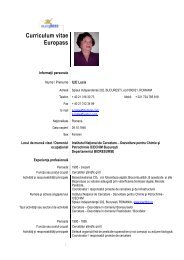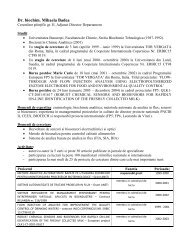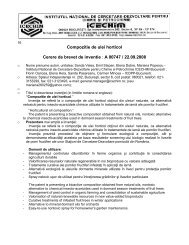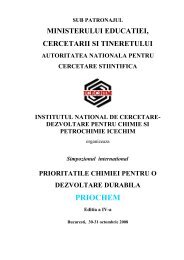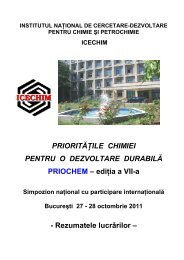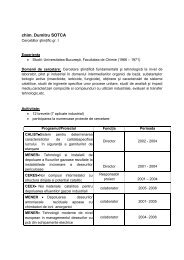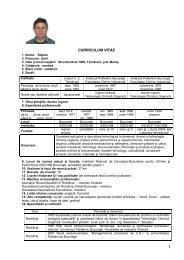INSTITUTUL NAÅ¢IONAL DE CERCETARE-DEZVOLTARE - ICECHIM
INSTITUTUL NAÅ¢IONAL DE CERCETARE-DEZVOLTARE - ICECHIM
INSTITUTUL NAÅ¢IONAL DE CERCETARE-DEZVOLTARE - ICECHIM
- No tags were found...
Create successful ePaper yourself
Turn your PDF publications into a flip-book with our unique Google optimized e-Paper software.
4 - Protection and Environmental Engineering - PPREPARATION AND CHARACTERIZATION OF POLYMER INCLUSION MEMBRANE WITHD2EHPA AND TOA AS CARRIERSLiliana Pacurariu 1,2 , Mariana Mateescu 1,2 , Gheorghe Nechifor 2 .1Faculty of Applied Chemistry and Materials Sciences, University ‘Politehnica’ of Bucharest, Bucharest,Romania2 National Institute for Research & Development in Chemistry and Petrochemistry - <strong>ICECHIM</strong> Bucharest, Spl.Independentei nr. 202, Bucuresti, RomaniaThe stability of polymer inclusion membranes (PIMs) relative to other liquidmembranes is amongst the major reasons for the recent rejuvenation of interest in carriermediatedtransport for selective separation and recovery of metal ions as well as numerousorganic solutes. This is reflected by an increasing number of PIM investigations reported inthe literature over the last two decades [1]. Polymer inclusion membrane (PIM) system withcellulose acetate polymer as support and tri-n-octylamine (TOA) and di(2-ethylhexyl)phosphoric acid (D2EHPA) as carriers has been developed which provides rapidmetal ion transport with high selectivity, as well as easy setup and operation.The PIMs are formed by casting cellulose triacetate (CTA) from solution to form athin film. The casting solution also contains an ion exchange carrier (TOA and D2EHPA) anda membrane plasticizer (e.g., an o-nitrophenyl alkyl ether 2-NPOE). The membrane is used toseparate aqueous source and receiving phases, but does not utilize an organic solvent tomaintain this phase separation. Therefore, PIMs are simpler to use than SLM, and do notsuffer from loss of the organic solvent. SUGIURA et al. [2] first utilized cellulose triacetate(CTA) membranes for carrier- mediated transport of metal ions from an aqueous source phaseinto an aqueous receiving phase.The efficiency of the membrane transport was optimized as a function of pH, stirringspeed, aqueous phases and membrane composition [3]. PIM was characterized by using FTIRand Scanning Electron Microscopy (SEM).References1. D. Long Nghiema, Patrick Mornanea, Ian D. Potter , Jilska M. Perera , Robert W. Cattrall , Spas D. Kolev ,“Extraction and transport of metal ions and small organic compounds using polymer inclusion membranes(PIMs)”, Journal of Membrane Science 281 (2006) 7–412. M. Sugiura, M. Kikkawa, S. Urita, Separ. Sci. Technol.,22 (1987) 22633. Clàudia Fontàs, Rafik Tayeb, Mahmoud Dhahbi, Emmanuelle Gaudichet, Francette Thominette, Pascale Royd, Karine Steenkeste, Marie-Pierre Fontaine-Aupart, Sophie Tingry, Emmanuel Tronel-Peyroz, Patrick Seta,“Polymer inclusion membranes: The concept of fixed sites membrane revised”, Journal of Membrane Science290 (2007) 62–72




